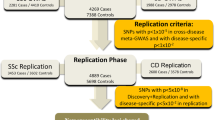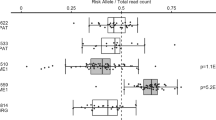Abstract
Cytokine and cytokine receptor genes, including IL2RA, IL7R and IL12A, are known risk factors for multiple sclerosis (MS). Excitotoxic oligodendroglial death mediated by glutamate receptors contributes to demyelinating reactions. In the present study, we screened 368 single-nucleotide polymorphisms (SNPs) in 55 genes or gene clusters coding for cytokines, cytokine receptors, suppressors of cytokine signaling (SOCS), complement factors and glutamate receptors for association with MS in a Spanish–Basque resident population. Top-scoring SNPs were found within or nearby the genes coding for SOCS-1 (P=0.0005), interleukin-28 receptor, alpha chain (P=0.0008), oncostatin M receptor (P=0.002) and interleukin-22 receptor, alpha 2 (IL22RA2; P=0.003). The SOCS1 rs243324 variant was validated as risk factor for MS in a separate cohort of 3919 MS patients and 4003 controls (combined Cochran–Mantel–Haenszel P=0.00006; odds ratio (OR)=1.13; 95% confidence interval (CI)=1.07–1.20). In addition, the T allele of rs243324 was consistently increased in relapsing-remitting/secondary progressive versus primary-progressive MS patients, in each of the six data sets used in this study (PCMH=0.0096; OR=1.24; 95% CI 1.05–1.46). The association with SOCS1 appears independent from the chr16MS risk locus CLEC16A.
This is a preview of subscription content, access via your institution
Access options
Subscribe to this journal
Receive 6 digital issues and online access to articles
$119.00 per year
only $19.83 per issue
Buy this article
- Purchase on SpringerLink
- Instant access to full article PDF
Prices may be subject to local taxes which are calculated during checkout
Similar content being viewed by others
References
Oksenberg JR, Baranzini SE . Multiple sclerosis genetics – is the glass half full, or half empty? Nat Rev Neurol 2010; 6: 429–437.
The International Multiple Sclerosis Genetics Consortium. Risk alleles for multiple sclerosis identified by a genomewide study. N Eng J Med 2007; 357: 851–862.
De Jager PL, Jia X, Wang J, de Bakker PIW, Ottoboni L, Aggarwal NT et al. Meta-analysis of genome scans and replication identify CD6, IRF8 and TNFRSF1A as new multiple sclerosis susceptibility loci. Nat Genet 2009; 41: 776–782.
The International Multiple Sclerosis Genetics Consortium. IL12A, MPHOSPH9/CDK2AP1 and RSG1 are novel multiple sclerosis susceptibility loci. Genes Immun 2010; 11: 397–405.
Matute C, Domercq M, Sánchez-Gómez MV . Glutamate-mediated glial injury: mechanisms and clinical importance. Glia 2006; 53: 212–224.
Lundmark F, Duvefelt K, Iacobaeus E, Kockum I, Wallström E, Khademi M et al. Variation in interleukin 7 receptor α chain (IL7R) influences risk of multiple sclerosis. Nat Genet 2007; 39: 1108–1113.
O'Doherty C, Kantarci O, Vandenbroeck K . IL7RA polymorphisms and susceptibility to multiple sclerosis. N Eng J Med 2008; 358: 753–754.
The International Multiple Sclerosis Genetics Consortium. The expanding genetic overlap between multiple sclerosis and type I diabetes. Genes Immun 2009; 10: 11–14.
Berard JL, Kerr BJ, Johnson HM, David S . Differential expression of SOCS1 in macrophages in relapsing-remitting and chronic EAE and its role in disease severity. Glia 2010; 58: 1816–1826.
Vandenbroeck K . Cytokine Gene Polymorphisms in Multifactorial Conditions. CRC Press: Boca Raton, 2006.
Srinivasan R, Sailasuta N, Hurd R, Nelson S, Pelletier D . Evidence of elevated glutamate in multiple sclerosis using magnetic resonance spectroscopy at 3T. Brain 2005; 128: 1016–1025.
Baranzini SE, Srinivasan R, Khankhanian P, Okuda DT, Nelson SJ, Matthews PM et al. Genetic variation influences glutamate concentrations in brains of patients with multiple sclerosis. Brain 2010; 133: 2603–2611.
Byun E, Caillier SJ, Montalban X, Villoslada P, Fernández O, Brassat D et al. Genome-wide pharmacogenomic analysis of the response to interferon beta therapy in multiple sclerosis. Arch Neurol 2008; 65: 337–344.
Comabella M, Craig DW, Morcillo-Suárez C, Río J, Navarro A, Fernández M et al. Genome-wide scan of 500 000 single-nucleotide polymorphisms among responders and nonresponders to interferon beta therapy in multiple sclerosis. Arch Neurol 2009; 66: 972–978.
Baker BJ, Akhtar LN, Benveniste EN . SOCS1 and SOCS3 in the control of CNS immunity. Trends Immunol 2009; 30: 392–400.
Maier J, Kincaid C, Pagenstecher A, Campbell IL . Regulation of signal transducer and activator of transcription and suppressor of cytokine-signaling gene expression in the brain of mice with astrocyte-targeted production of interleukin-12 or experimental autoimmune encephalomyelitis. Am J Pathol 2002; 160: 271–288.
Stark JL, Cross AH . Differential expression of suppressors of cytokine signaling-1 and -3 and related cytokines in central nervous system during remitting versus non-remitting forms of experimental autoimmune encephalomyelitis. Int Immunol 2006; 18: 347–353.
Balabanov R, Strand K, Goswami R, McMahon E, Begolka W, Miller SD et al. Interferon-gamma-oligodendrocyte interactions in the regulation of experimental autoimmune encephalomyelitis. J Neurosci 2007; 27: 2013–2024.
Mujitaba MG, Flowers LO, Patel CB, Patel RA, Haider MI, Johnson HM . Treatment of mice with the suppressor of cytokine signaling-1 mimetic peptide, tyrosine kinase inhibitor peptide, prevents development of the acute form of experimental allergic encephalomyelitis and induces stable remission in the chronic relapsing/remitting form. J Immunol 2005; 175: 5077–5086.
Tanaka K, Ichiyama K, Hashimoto M, Yoshida H, Takimoto T, Takaesu G et al. Loss of suppressor of cytokine signaling 1 in helper T cells leads to defective Th17 differentiation by enhancing antagonistic effects of IFN-gamma on STAT3 and Smads. J Immunol 2008; 180: 3746–3756.
Gylvin T, Ek J, Nolsøe R, Albrechtsen A, Andersen G, Bergholdt R et al. Functional SOCS1 polymorphisms are associated with variation in obesity in whites. Diabetes Obes Metab 2009; 11: 196–203.
Harada M, Nakahima K, Hirota T, Shimizu M, Doi S, Fujita K et al. Functional polymorphism in the suppressor of cytokine signaling 1 gene associated with adult asthma. Am J Respir Cell Mol Biol 2007; 36: 491–496.
Zuvich RL, McCauleu JL, Oksenberg JTR, Sawcer SJ, De Jager PL, IMSGC et al. Genetic variation in the IL7RA/IL7 pathway increases multiple sclerosis susceptibility. Hum Genet 2010; 127: 525–535.
Wykes SM, Nelson JE, Visscher DW, Djakiew D, Krawetz SA . Coordinate expression of the PRM1, PRM2, and TNP2 multigene locus in human testis. DNA Cell Biol 1995; 14: 155–161.
Beyeen AD, Adzemovic MZ, Ockinger J, Stridh P, Becanovic K, Laaksonen H et al. IL-22RA2 associates with multiple sclerosis and macrophage effector mechanisms in experimental neuroinflammation. J Immunol 2010; 185: 6883–6890.
Genetic Analysis of Psoriasis Consortium et al. A genome-wide association study identifies new psoriasis susceptibility loci and an interaction between HLA-C and ERAP1. Nat Genet 2010; 42: 985–990.
Lin PI, Vance JM, Pericak-Vance MA, Martin ER . No gene is an island: the flip-flop phenomenon. Am J Hum Genet 2007; 80: 531–538.
Clarke GM, Cardon LR . Aspects of observing and claiming allele flips in association studies. Genet Epidemiol 2010; 34: 266–274.
Ban M, Goris A, Lorentzen AR, Baker A, Mihalova T, Ingram G et al. Replication analysis identifies TYK2 as a multiple sclerosis susceptibility factor. Eur J Hum Genet 2009; 10: 1309–1313.
Vandenbroeck K, Alloza I, Swaminathan B, Antigüedad A, Otaegui D, Olascoaga J et al. Validation of IRF5 as multiple sclerosis risk gene: putative role in interferon beta therapy and human herpes virus-6 infection. Genes Immun 2011; 12: 40–45.
Kristjansdottir G, Sandling JK, Bonetti A, Roos IM, Milani L, Wang C et al. Interferon regulatory factor 5 (IRF5) gene variants are associated with multiple sclerosis in three distinct populations. J Med Genet 2008; 45: 362–369.
Poser CM, Paty DW, Scheinberg L, McDonald WI, Davis FA, Ebers GC et al. New diagnostic criteria for multiple sclerosis: guidelines for research protocols. Ann Neurol 1983; 13: 227–231.
MacDonald WI, Compston A, Edan G, Goodkin D, Hartung HP, Lublin FD et al. Recommended diagnostic criteria for multiple sclerosis: guidelines from the International Panel on the diagnosis of multiple sclerosis. Ann Neurol 2001; 50: 121–127.
Purcell S, Neale B, Todd-Brown K, Thomas L, Ferreira MA, Bender D et al. PLINK: a tool set for whole-genome association and population-based linkage analyses. Am J Hum Genet 2007; 81: 559–575.
Barrett JC, Fry B, Maller J, Daly MJ . Haploview: analysis and visualization of LD and haplotype maps. Bioinformatics 2005; 21: 263–265.
Skol AD, Scott LJ, Abecasis GR, Boehnke M . Joint analysis is more efficient than replication-based analysis for two-stage genome-wide association studies. Nat Genet 2006; 38: 209–213.
Johnson AD, Handsaker RE, Pulit SL, Nizzari MM, O’Donnell CJ, de Bakker PI . SNAP: a web-based tool for identification and annotation of proxy SNPs using HapMap. Bioinformatics 2008; 24: 2938–2939.
Acknowledgements
We express our gratitude to all patients and control subjects participating in this study. We thank the Basque Biobank of the Basque Foundation for Health Innovation and Research for supplying DNA samples. This study was supported by grants to K Vandenbroeck from the European Community's Seventh Framework Program (FP7/2007-2013) under grant agreement no 212877 (UEPHA*MS; www.reem.es/uepha-ms/), and from the Gobierno Vasco (Ref. IT512-10; Convocatoria ‘Grupos de Investigación 2010–2015’); by grants to A Aransay from the Gobierno Vasco (Ref. MV-2005-1-13; ‘Convocatoria de Programas de Perfeccionamiento y Movilidad del Personal Investigador 2005’), the Department of Industry, Tourism and Trade of the Government of the Autonomous Community of the Basque Country (Etortek Research Programs 2005–2006) and from the Innovation Technology Department of the Bizkaia County; by project grant FIS PI10/1985 to E Urcelay; by grants to A Alcina from the Fondos Europeos de Desarrollo Regional (FEDER), Ministerio de Ciencia e Innovación (SAF2009-11491) and Junta de Andalucía (P07-CVI-02551); and by grant FIS PI/081636 to F Matesanz.
Author information
Authors and Affiliations
Corresponding author
Ethics declarations
Competing interests
The authors declare no conflict of interest.
Rights and permissions
About this article
Cite this article
Vandenbroeck, K., Alvarez, J., Swaminathan, B. et al. A cytokine gene screen uncovers SOCS1 as genetic risk factor for multiple sclerosis. Genes Immun 13, 21–28 (2012). https://doi.org/10.1038/gene.2011.44
Received:
Revised:
Accepted:
Published:
Issue Date:
DOI: https://doi.org/10.1038/gene.2011.44
Keywords
This article is cited by
-
What Have Failed, Interrupted, and Withdrawn Antibody Therapies in Multiple Sclerosis Taught Us?
Neurotherapeutics (2022)
-
Suppressor of cytokine signaling-1 mimetic peptides attenuate lymphocyte activation in the MRL/lpr mouse autoimmune model
Scientific Reports (2021)
-
Genetic and Molecular Biology of Multiple Sclerosis Among Iranian Patients: An Overview
Cellular and Molecular Neurobiology (2020)
-
CpG Island Methylation Patterns in Relapsing-Remitting Multiple Sclerosis
Journal of Molecular Neuroscience (2018)
-
SncRNA (microRNA & snoRNA) opposite expression pattern found in multiple sclerosis relapse and remission is sex dependent
Scientific Reports (2016)



